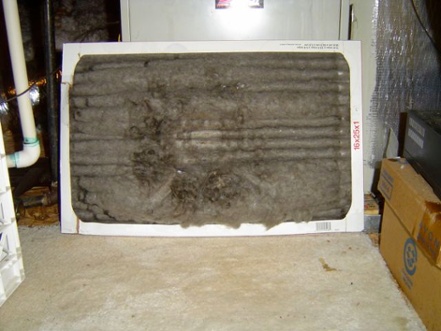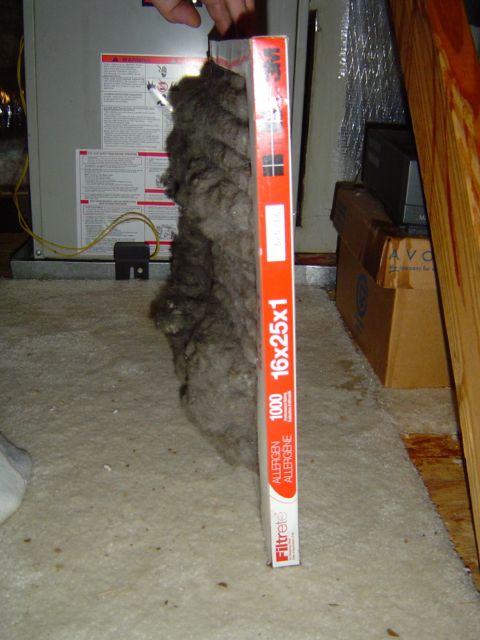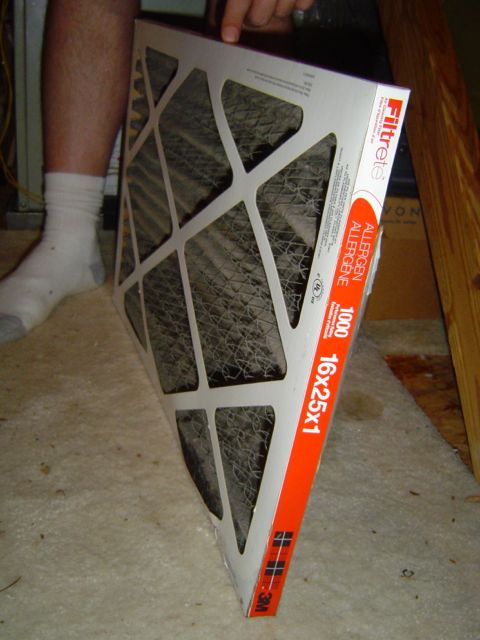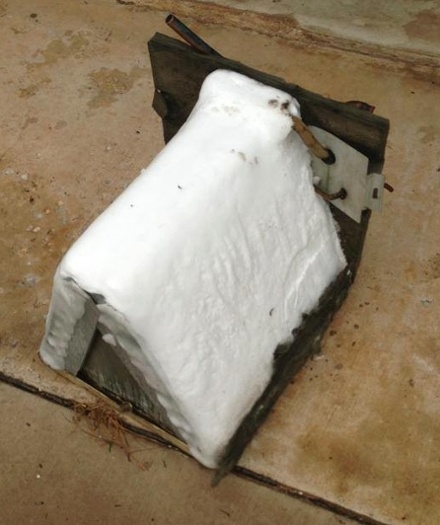An Interesting Way To Freeze Your Air Conditioner Coil

You know how when you change the filter in your air conditioner, it has a little arrow on the edge showing which way the air is supposed to flow through it? What do you think happens if you put it in with the arrow in the wrong direction? And then let it get too dirty? That’s what happened with the filter below.
You know how when you change the filter in your air conditioner, it has a little arrow on the edge showing which way the air is supposed to flow through it? What do you think happens if you put it in with the arrow in the wrong direction? And then let it get too dirty? That’s what happened with the filter below.
Notice that it’s dirty. Notice also that it seems to be a bit lighter in color in the center.

Looking at it from the side (above), you can see that the filter material is blown out. The blower in the air conditioner was trying really hard to pull air through the filter but the static pressure across it was high because of the dirt.

Looking at the other side of the filter, you can see the wire mesh is now separated from the filter fabric. Of course, now it’s clear why that wire mesh is there in the first place. It holds the filter fabric in place to keep it from getting sucked into the blower.
What happened here is that the air conditioner pulled so hard on that filter that it sucked big chunks of the dirt and fabric off of the filter. Then it deposited them on the evaporator coil. A while back I wrote about a dirty evaporator coil, and that one had a large accumulation of small stuff.
In either case, the result is that air can’t move through the coil very well. The coil gets colder and colder because it’s not picking up heat from the house. There’s some water there because of the air that does get there. Then the coil turns into a block of ice.

The photo above is not from the house where I took those filter photos because I didn’t open up the unit. It was definitely frozen up, though, because the ice was even coming out of the housing. The photo here does show what happens, and you can see that when a coil freezes up, no air will move through it. This picture is from one of my favorite Facebook pages, HVAC hacks and other screwups.)
Related Articles
The Sludge That Kills — Post Mortem of an Air Conditioner
This Post Has 8 Comments
Comments are closed.

You’ve written about this
You’ve written about this twice, but as far as I can see haven’t described how low airflow kills compressors, the heart of any AC system…let me count two ways:
In an older system, a fixed amount of liquid refrigerant is released into the evaporator. If the evaporator is coated in dirt or ice, that refrigerant never boils off into gas, so returns to the compressor as a liquid. Liquid isn’t compressible, but that compressor doesn’t know that and dies trying.
In a newer system, a smart valve (a thermostatic expansion valve,TXV, for the geek in all of us) allows only enough refrigerant that will completely boil off within the evaporator to pass through.
The smart valve prevents liquid getting back to the compressor by pinching off the flow of refrigerant into the evaporator. That fixes one problem but causes another – Compressor is cooled by returning refrigerant. If the TXV pinches off in response to very low airflow, the compressor is deprived of needed coolant, overheats and dies.
Compressors don’t die, they are murdered!
Some more “Cool”
Some more “Cool” information, I inform my clients that… “Your utility company sends you a monthly reminder to check your filter, their “monthly bill!”. Changing or cleaning your filter each month will reduce your utility and maintenance bills”
Allison,
Allison,
I always find out interesting things when I take things apart. Our bedroom window air conditioner blower (old house, no ducts, yadda yadda) recently started making strange thumping noises so I removed it and took it apart (turned out to be the blower fan hub had broken in several pieces). While I had it apart, I noticed that the rear/outside coil was completely covered on the inside with dirt. The front/inside coil was really clean because I clean the interior filter, but the rear/outside coil is exposed to ambient air and only has some side louvers to screen out the really big stuff. A couple minutes with the garden hose in “reverse flush mode” and it is fine again. I never even thought about this before and I wonder how many other window air conditioners are scrapped when all they need is a seasonal hosing?
Poor maintenance keeps hvac
Poor maintenance keeps hvac guys in bussiness!
It can only be good when
It can only be good when people pay more attention to static pressure. I have seen a cheap gadget which fits on the filter and measures the pressure drop across the filter. That would have addressed the problem — though I predict a filter will go rather longer than a month before requiring replacement.
Carrier high end controls will tell “external static pressure” (ESP), and a rise in ESP will signal a need to change the filter. Okay that is expensive stuff and not applicable to the majority of people.
It really is not hard to connect a manometer to parts of the forced air system, to 1) evaluate whether the blower has to work against a too-small duct design, and 2) to monitor whether this type of filter is restricting airflow. It is thoroughly geeky, but I have bought Dwyer liquid manometers for $25, and mechanical devices can be had for 3X that.
Instead I find most AC techs unfamiliar with this measurement, they consider it something special, and consequently issue advice on a one-size-fits-all basis. For example “avoid 3M Filtretes because they are too restrictive”, “if you have poor cooling, we will just upsize a ton”, etc.
Restricted air flow is
Restricted air flow is inefficient and can cause freeze up (with an old DX valve) or as Curt said above, you overheat the compressor due to the restricted TXV. Not only is this a coil issue: You are also working the fan harder and you can roast your heat exchanger in the winter.
The deeper and larger the filter the longer they last with out high ESP. I retrofitted my 1″ filter with a 5″ thick filter with larger length and width. ESP was is now very low and the filters last 6 months. More filter surface area is the key. I thought about dropping an industrial bag filter into the return duct, but those are very expensive (my furnace is in the basement so, I would have had about 6 FEET of filter depth!). Those dense, high efficiency 1″ pleated filters are very restrictive right out of the box. M. Johnson, good point on the Dyer manometer. It should be standard equipment on any system. Also, ducts are often under-sized, especially return ducts. My evap coil is as big as Lennox would allow for the condensing unit. This increases de-humidification and pushes SEER up.
One other factor which may be
One other factor which may be important here: filter sizing. People are not *used* to math in the form of filter face speed, but that illustrates an important principle (you can also express this number in square inches per ton of AC, if you find that convenient). So many filters themselves are undersized for the air flow through them. If more filters were of appropriate size, they would last far longer without real restriction to air flow.
Unlike many things, it appears there is no downside to having larger filter area instead of smaller. It is much cheaper to add a return with additional filter area, than to replace most major system components. You may find this controversial but… using my manometer measurements (and very generous filter area) I find that filters need to be replaced far less often than monthly.
As this relates to a common failing, I think this topic is worthy of an entire blog post dedicated to it: are you interested Allison?
One of the simplest pieces of
One of the simplest pieces of the system to check and maintain and yet this happens. Seen it too many times. Truly shaking my head on this one.